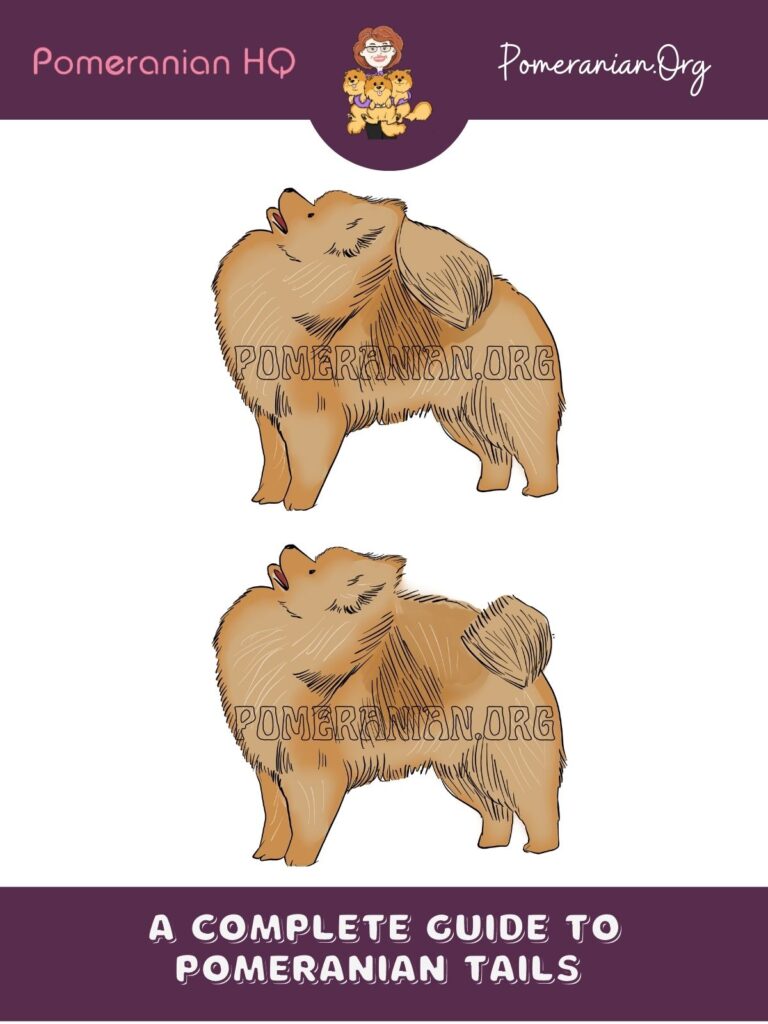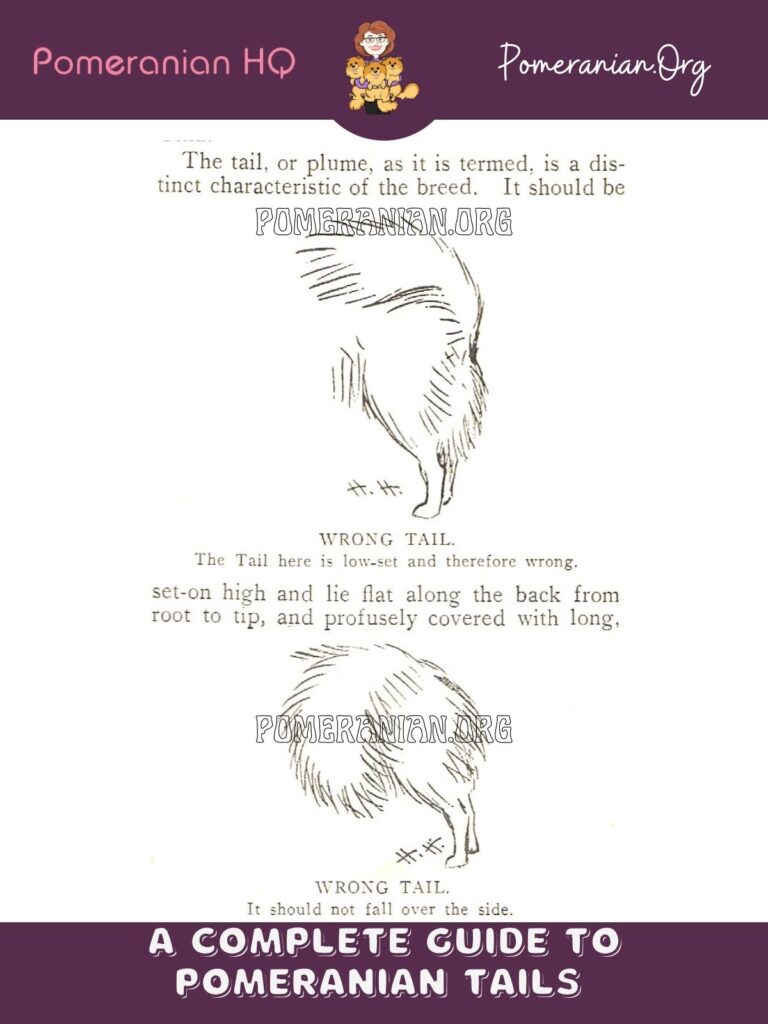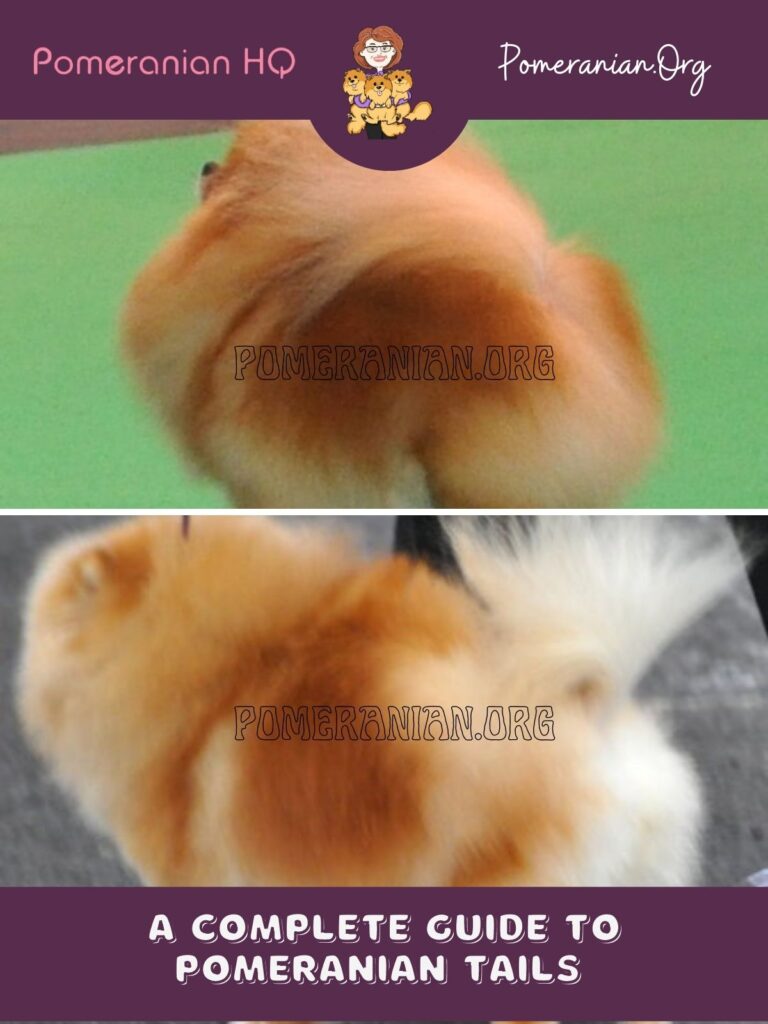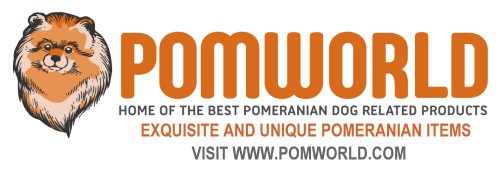Last Updated on 24/04/2024 by Dochlaggie. Post first published on June 23, 2023.
Are you the proud parent of a Pomeranian pup? This adorable breed is known for its fluffy coats and outgoing personalities. If you’ve been curious about a characteristic that truly sets this small breed apart, look no further than their unique tail! This article covers everything from the origins of the Pomeranian tail to how to care for it properly. Read on to learn more about your pup’s signature feature!
Pomeranians are known for their adorable looks and loveable personalities. They are truly unique dogs, right down to their tails! So many things make Poms adorable, one of which is their tails.
What Does a Pomeranian Tail Look Like?
The Pomeranian tail, also known as the plume, is heavily coated, set high, and lies flat and straight on the back. The Pom tail is unique to the Pomeranian.
It is profusely covered with long, harsh, straight hair. According to the official breed standard, the tail of the Pomeranian dog is carried high over the back of the Pomeranian, with parts of the plume reaching the head.
Tail – heavily plumed, set high and lies flat and straight on the back. Major Fault – Low tail set.
American Kennel Club Pomeranian Breed Standard
Tail:
The Pomeranian Club UK Pomeranian Breed Standard
Characteristic of breed, high set, turned over back and carried flat and straight, profusely covered with long, harsh, spreading hair.
Tail: The tail is set on high and of medium length. It reaches
FCI : German Toy Spitz / Pomeranian Breed Standard
upwards and rolls forward over the back, straight from the root. It lies firmly over the back and is covered with very bushy hair. A double curl at tip of tail is tolerated.
The Pomeranian tail hair spreads out in a fan shape. The tail, covered in long spreading hairs, rests on the back like a fan. The buttocks are set well behind the root of the tail. A proper high tail set has no feel of boniness at the base.
- If the tail is set high on the end of the backbone, it should not feel like a hard bone pressing into the palm when the palm is placed flat against the tail root.
- If the tail root has a twist to the set, the tail will not lie flat but will fall over to one side, no matter how high the set, with the plume.
Why Do Pomeranians Have Tails That Curl Over Their Backs?
Pomeranians are members of the Spitz family, which includes many northern snow breeds. Poms originally come from sub-zero temperatures, so they need extra protection against the elements.
Most of the tails of spitz dog breeds, including Pomeranians, curl over their backs. These furry curly tails helped keep their ancestors’ warm and were perfect for wrapping over their faces and head when lying down.
The shape of a Pom’s tail allows it to have the end of its tail over its nose to keep it warm. This kept their ancestors warm and prevented their tender noses from getting frostbit. This is a genetic quality that has been passed down through many generations.
A Low Tail-set Spoils The Outline of the Pomeranian Dog?
Pom tails should lay flat or fall to one side. Poms are a breed that does not have a curly tail.
A kinked or curly tail is a breed fault. A low tail set spoils the outline of the show Pomeranian. A Pomeranian is supposed to be ball-shaped, and the correct tail helps to give the illusion of a ball-shaped dog.
If the dog’s tail is set low, the bone will press into the palm, and the root can be seen to protrude outward and upwards instead of disappearing into a flat plume up the back.
Pom puppies may often damage their tail during rough play with other pups. You must be careful not to allow rough play with your Pomeranian puppy.
What Causes a Pomeranian Dog’s Tail to Curl?
The shape of the vertebrae plays a major role in many visible aspects of your Pomeranian tail. For Poms, the curl in their tails is caused by hemivertebrae.
The hemivertebrae condition or wedge-shaped vertebrae is a common trait in Pomeranians. This is a genetic or congenital condition in which the vertebrae in your dog’s tail are fused together in a curl or a wedge shape.
Did you know that a dog’s tail is a flexible continuation of a dog’s spine and comprises many small bones? This contributes to the tail shape of the individual dog. It has 6 to 23 vertebrae that get smaller and smaller as you get closer to the tip of its tail.

When Do Pomeranian Puppies’ Tails Start To Curl Over Their Back?
The Pomeranian puppies‘ tails stay straight at birth. As the puppy grows, the tail develops and curls over the dog’s back. Pom puppies’ tails curl up over the back 3 to 4 weeks after birth.
As time passes, the tail’s curl will be much more visible. In 5 to 6 weeks, the tail should sit nicely over the pup’s back.
Around 4 to 6 months in age, a Pomeranian may be teething, and during this time period, low calcium levels may cause a Pomeranian puppy to hold its tail in odd positions.
If your Pom puppy’s tail isn’t curled up over the back at seven months, take it to a vet for a thorough check-up.
What Is The Purpose of a Pomeranian Tail?
Tails are a big way in which Pomeranians communicate with us. Poms can’t use words; they use their tails to tell us when they are happy, sad, scared, and even injured.
When determining how your Pomeranian dog feels, pay attention to the height of its tail. If held high, the dog is excited and alert, while a tail tucked close to the body might show fear and anxiety. There may be a few reasons if your Pomeranian’s tail is down.
- They are uncomfortable or frightened.
- Overexertion
- Exposure to extreme weather or water
- Prolonged confinement
- Muscle injury
- Medical issues
Tucking the tail between the legs signals submission and fear in Pomeranians. Poms will tuck their tails in to hide their anal glands.
A tail laying down is equivalent to hiding your dog’s face because it covers the genitals and interferes with the sniffing behavior that identifies your Pomeranian to other dogs. When your Pomeranian is relaxed and no longer scared, its tails usually return to their normal curled over their back position.
Why Doesn’t My Pomeranian Wag His Tail?
There are several possible reasons why your Pomeranian doesn’t wag his tail.
- Depression: Your Pomeranian might stop wagging his tail suddenly after an event has caused him to become depressed
- Tiredness: Another possible reason is that your Pom is tired. This would be more likely if your furry companion has stopped wagging his tail since an event that might have caused him to become tired and exhausted.
- Injury: Pomeranian might stop wagging his tail if he has gotten an injury or illness. If you observe more symptoms, the best option is to take your dog to a vet.
- Anal gland issues: Sometimes, anal glands can become filled with too much fluid, or the fluid can develop into a thick paste-like substance. If either of these issues develops, it can cause a Pomeranian to feel very uncomfortable and, in turn, have trouble wagging or resisting moving it.
- Boredom: Another possible cause is that your Pomeranian is bored.
- Limber tail: If your Pomeranian has overworked tail muscles, you may notice an absence of wagging.
- Scared: If your dog is scared or frightened, he will keep his tail between his legs and not wag the tail at all.

Why Is My Dog’s Tail Limp?
A limper tail is a condition in which active dogs suddenly develop a limp tail. The condition is usually due to a sprain or strain of the muscle groups supporting the tail.
Overexertion, strenuous physical activity, and prolonged crate confinement are the underlying problem for the limber tail. This causes damage to the muscles, ligaments, and tendons at the base of the tail.
As the tail is also used for balance, a dog with a limber tail may have difficulty getting up after lying down. Some dogs are unable to get comfortable when lying down. Pain is usually associated with a limber tail. So, the tail will droop, and a dog won’t be able to wag it.
How Does Muscular Sprain or Strain Occur In a Pom’s Tail?
These conditions are usually caused by:
- Swimming
- Crate confinement over an extended period of time.
- Exposure to extremely cold temperatures
- Excessive physical activity without adequate conditioning
- Other severe climate changes
Swimming is the most prevalent cause of Pomeranian limber tail, which may be caused to the cool water temperatures and the physical activity involved. Swimming requires dogs to utilize their tails to assist with balance and steering, resulting in overexertion compared to typical dry-land hobbies, such as playing fetch.
A limber tail can afflict any dog; however, Pomeranians and some breeds are more susceptible to the condition due to their unique habits.
Caring For Pomeranian Tails
Pom tails and the surrounding area must always be kept clean. Neglecting the tail and the rear end can cause health problems like redness, dry skin, inflammation, yeast or bacterial infections, and irritation.
From cleaning to soothing, here’s what you need to do:
- Pay special attention to their tail and rear area. You must ensure that the rear area is always clean.
- When brushing, combing, and bathing your Pomeranian, check his tail for burrs, tangles, mats, and any injuries. You can catch minor injuries early and care for them by checking his tail regularly. Tail hair often requires special attention.
- Pulling your Pomeranian’s tail can cause nerve damage to the tail.
- If tail injuries occur, keep the wound clean and comfort the dog.
Keep your Pomeranian tail healthy all the time! Always make sure the area is completely dry when you are finished cleaning.
If you notice irritated skin or an unusually foul smell coming from your Pomeranian tail area, don’t hesitate to take your dog to the vet. Also, many tail injuries require veterinary attention. With proper care, your Pomeranian will hopefully wag his tail again soon.

What Dog Breeds Carry Their Tails Up Over The Back?
These dog breeds carry their tails over the back:
- Akita
- Shiba Inu
- Samoyed
- Pug
- Alaskan Malamute
- American Eskimo
- Norwegian Elkhound
- Keeshond
- Chow Chow
- Basenji
- German Spitz
- Finnish Spitz
- Siberian Husky
- Icelandic Sheepdog
- Swedish Lapphund
Can Pomeranians Feel Pain in Their Tails?
All dogs can feel pain in their tails. The tail is part of a dog’s spine and has bones and muscles. Like all dog breeds, Pomeranians have nerves inside their tails’ vertebrae.
Pomeranian Tail FAQs
What Is The Purpose Of The Pomeranian Tail?
The tail of a Pom is used for various purposes, including balance, warmth in the cold, to protect from frostbite, communication, and movement.
Are The Tails Curled Over The Back At Birth?
Pomeranian pups are born with their tails in a straight position. Approximately four weeks after birth, a puppy’s tail will begin to rest on its back.
Is It Normal For A Pomeranian’s Tail To Seem Uneven?
While your puppy is developing, it is typical for the various vertebrae to thicken at varying rates at different points in the growth process. During this developmental period, the Pomeranian tail may feel uneven and asymmetrical.
If you see any bumps or irregularities in your Pom’s tail, you should immediately take him to the veterinarian. Your veterinarian may need to check your puppy’s calcium levels to ensure they are within normal ranges. Low or excessive calcium levels harm your Pom’s health and can result in distortion of the vertebrae and other problems.
Is It Normal For A Pomeranian’s Tail To Hang Down?
Pomeranian tails are not supposed to hang down in normal circumstances. Tail dangling in your Pom’s case might indicate an injury, fracture, or health problem, such as clogged or infected anal glands. It’s preferable if you call your veterinarian so that your dog may be addressed properly.
Final Thoughts On The Pomeranian Tail
Pomeranians are great in many ways, and their tails certainly help with the cute factor. Regardless of Pomeranian tail shape, one thing is certain: the friendship, loyalty, and love your Pom gives you can’t be beaten. With their glamorous coat, fluffy tail, and sweet face, Pomeranians won’t need to ask for your attention twice.
Proper care and good hygiene can be a great way to keep your Pomeranian tail healthy. Give your Pom a healthy and happy life full of endless tail wags! They need plenty of love and time to thrive.
Hope you enjoyed reading this article about Pomeranian tails! Feel free to share your thoughts and questions. We would be happy to hear from you!
Copyright Pomeranian.org. All Rights Reserved.
N.B. This article regarding Pomeranian health issues was written in consultation with our resident veterinarian.
Dr. Muqeet Mushtaq
DVM, University of Animal and Veterinary Sciences, 2019
MSc. (Hons.) (Animal Breeding & Genetics), University of Agriculture Faisalabad, 2021
References and Further Reading:
[1] Official Standard of the Pomeranian (AKC). American Kennel Club, 2011.
[2] English Kennel Club Pomeranian Breed Standard, 2017.
[3] Denise Leo, The Pomeranian Handbook.
[4] Milo G. Denlinger “The Complete Pomeranian.”
[5] Kimbering Pomeranians “1891-1991”.
[6] William Taplin’s “The Sportsman’s Cabinet.”
[7] E. Parker “The Popular Pomeranian.”
[8] Lilla Ives “Show Pomeranians.”








